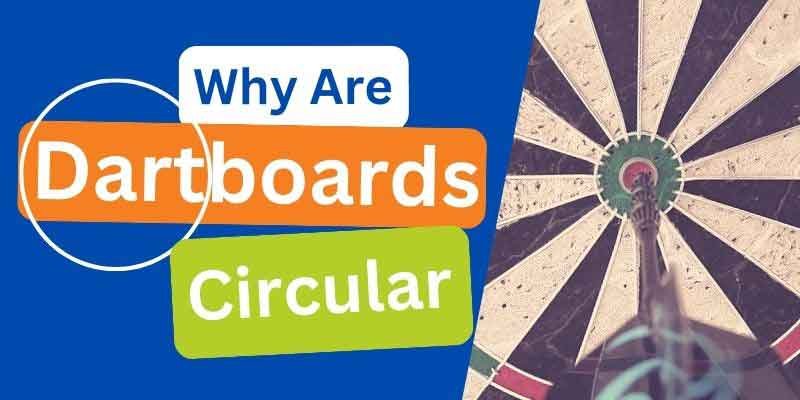Why Are Dartboards Circular?

Key Takeaways:
- The original dartboards were cross-sections of tree trunks, and the radial cracks likely inspired the pie-section-like divisions on modern dartboards.
- Dartboards are circular to allow for precise aiming and scoring. The concentric circles provide a detailed scoring system that cuts back on lucky shots ruling the game.
- The modern dartboard has four main parts: double ring, triple ring, outer bullseye, and inner bullseye. Each of the twenty pie slices is boarded with a metal wire to prevent questionable scores.
- The most central circle, the eye of the bullseye, is worth 50 points and the perfect score, or “ton 80”, is a total of 180 points from three dart throws.
- Darts has a long and rich history, from being played by soldiers for target practice to a popular pastime found in homes and establishments across the globe.
History of Dartboards
The circular shape of a dartboard is no shock to anyone today, but it hasn’t just been plucked from thin air.
To understand why it is made of concentric circles, you have to delve a little into the history of dartboards, which dates back centuries.
- Despite the popularity of the game, the true history of darts remains a mystery
- Some believe it originated as a way for soldiers to practice their aim
- Others attribute its origins to pub games in England
Concentric Circles on a Dartboard
The practice of using concentric circles on a dartboard has evolved over time.
The modern version of the dartboard, with its twenty numbered sections, is believed to have first appeared in the early part of the 20th century.
The initial beginnings are thought to have come from cross-sections of tree trunks.
The splits in the wood, formed during the aging process, acted to separate the circular shape into scoring segments.
- Players would then use sharp objects, probably spears, to throw them towards the circular wooden target
- It was seen as a similar game to archery, except could be played in smaller spaces
Because it could be played on a circular block of wood, it could be played indoors. This is believed to be where the game of darts originated and formed the inspiration for modern day dartboards.
Modern Day Dartboards
During the early days, the numbering system was inconsistent and the lack of a standard board become apparent as the game grew worldwide.
There was a definite need to develop better scoring systems and a rule set to govern the game.
Towards the end of the 1920s, the first standardized dartboard was developed, aka the London board with concentric circles.
- Keeping the circular shape and dividing the board into numbered scoring segments was the obvious choice.
- It meant every game was fair and provided a balanced playing experience while still incorporating elements of skill and strategy.
By the 1970s the spider, aka the wired rings, were introduced and placed a barrier between each segment.
This got rid of any disputes regarding the segments the darts landed in.
Structure of Modern Dartboards
The standardized design of modern dartboards has evolved in response to various factors, such as the need to play indoors, the ability to use darts of differing weights, and the desire to create a more challenging game.
Modern technology has allowed the mass production of consistent and high-quality dartboards.
- In the early days, dartboards were made of wood that had to be soaked overnight
- The development of bristle boards, made from sisal fibers, changed things, and they no longer need to be soaked
- Sisal fiber boards remain one of the most popular type of dartboards today
Bristle Dartboards
One of the unique features of bristle dartboards is that they are created from materials that can self-heal over time.
The densely packed sisal fibers close the hole back in, when a dart is removed from the board.
However, even self-healing boards won’t last forever, and environmental factors, along with usage, commonly cause bulging in a dartboard. T
o ensure a long-lasting and high-quality board, it is essential to rotate a dartboard regularly.
The Purpose of Centric Circles
Modern dartboards, includes:
- An outer bullseye
- An inner bullseye
- A small single followed by a treble
- A large single followed by a double
Each concentric circled section is layered and divided around the board into 20 different segments.
The different segments are designated with specific numbers. These sections are strategically placed to provide a variety of scoring opportunities for players.
The mechanics of throwing darts require precise aiming and strategic positioning of the body.
The traditional circular design of a dartboard adds to the challenge and excitement of gameplay and scoring.
The purpose of the concentric design is to allow greater precision. It also gives more opportunities to score as opposed to no score, which simulates a more exciting game among players.
Final thoughts on Why Are Dartboards Circular?
Dartboards have evolved over the years, from the use of tree slices to the modern bristle boards that are more durable and consistent. The circular shape has always been a key component in the history of darts.
However, as the game become popular, the need to develop a standard introduced the idea of concentric circles to achieve a greater level of precision. Rule variations and different games add to the complexity of the sport, making it a popular pastime for players of all skill levels.
FAQs about Why Are Dartboards Circular?
Why Are Dartboards Circular?
The circular nature of dartboards can be traced back to its historical origins. The original dartboards were cross-sections of tree trunks, and the pie-section-like divisions in dartboards today were inspired by the radial cracks that appeared in the aged wood. Concentric circles make up the design that provide precise scoring.
What Are the Advantages of the Circular Dartboard Design?
The circular dartboard design, with its concentric circles and numbered segments, allows for precise scoring and fair play. It also reduces the probability of lucky shots ruling the game and promotes skill-based play. The design is practical, functional, and aesthetically pleasing.
What Are Some Game Variations That Can Be Played on a Dartboard?
There are a variety of game variations that can be played on a dartboard. Some popular ones include 501, 301, Round the Clock, Cricket, and Killer. These game variations offer different complexities in scoring and aim, giving players a diverse set of options to choose from.
Are There Any Digital Boards That Keep Track of Scores?
Yes, there are electronic or digital dartboards that keep track of scores automatically. With these boards, players do not have to do the dirty work of manually calculating and tracking scores. The digital board keeps an accurate record of the value of each dart strike and the running scores.
Was Darts Ever Considered an Illegal Game of Chance?
Yes, darts was once considered an illegal game of chance and was outlawed in the 1900s. The game was viewed as a way of gambling, and establishments that allowed it were often fined. The modern-day version of darts, however, is a respected and popular pastime that can be found in homes and pubs all over the world.
What Is the Significance of the Numerical Scoring System Among the Concentric Circles?
The numerical scoring system among the concentric circles ensures a fair and balanced game. The design allows for precise scoring, cutting back on the probability of lucky shots ruling the game and allowing it to rely more on skill. Each radial segment is boarded with a metal wire, making it near impossible to hit a questionable number.
References
https://emeraldgr.com/history-of-the-dartboard/
https://www.tradgames.org.uk/games/Darts.htm
https://patrickchaplin.com/2019/05/21/history-of-the-dartboard/






